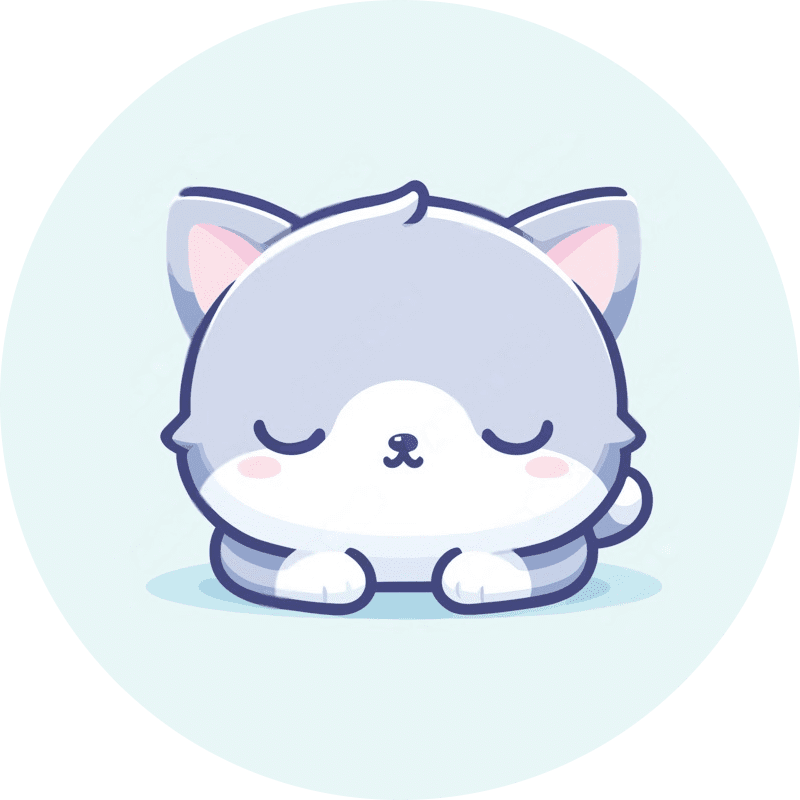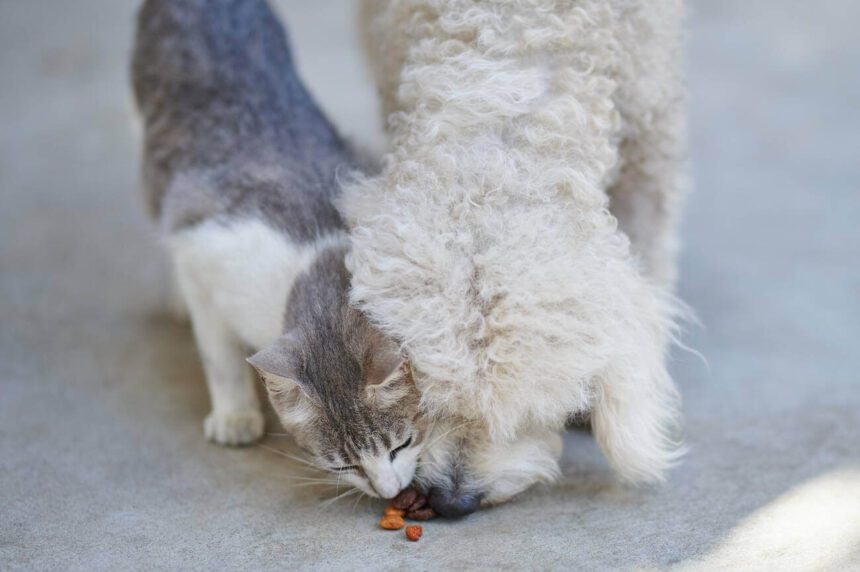Welcoming a new puppy into your home is an exhilarating experience, but it also ushers in unique challenges, particularly if you share your space with other pets, like those mysterious feline creatures. Puppies, with their boundless curiosity and relentless desire to explore, often find themselves inexplicably drawn to the tantalizing aroma of cat food. Herein lies a common conundrum for pet owners – how to keep a puppy out of cat food?
While it may seem like a trivial issue, this habit can lead to several problems for both your playful pup and the enigmatic feline cohabitant. However, fret not, dear reader! This article is your trusty guide on this furry predicament. We’ll equip you with the knowledge and techniques to ensure a peaceful coexistence between your pets.
Why Does a Puppy Raid the Cat’s Food Bowl?
The enigma of why puppies raid the cat’s food bowl is not so mysterious after all. Several factors can explain this peculiar behavior:
Similar Smell and Taste
Cat food often boasts flavors that can be irresistible to dogs, such as meaty goodness. The robust aroma and flavors of cat food can be quite tempting for puppies.
Accessibility
If your puppy finds it easy to reach the cat’s food bowl, curiosity is bound to get the better of them. Puppies, by nature, are inquisitive and may not always distinguish between their food and the feline’s.
Higher Fat Content
Cat food typically contains higher levels of fat and protein compared to dog food, meeting the unique nutritional needs of our feline friends. While an occasional taste test may not spell immediate disaster, regular indulgence can upset your pup’s dietary balance.
Nutritional Imbalances
Puppies have specific dietary requirements distinct from both adult dogs and cats. Dog food is formulated to meet the needs of their growth and development, packing essential nutrients like calcium and phosphorus. Cat food, however, may fall short in satisfying these needs, possibly leading to nutritional imbalances.
To ensure your puppy receives the nutrition they need, it’s crucial to restrict their access to cat food if they’ve already had a taste. But rest assured, this doesn’t warrant an immediate emergency. If you’re concerned about your pup’s diet or health, a visit to the veterinarian can offer tailored guidance.
How to Keep That Playful Pup Out of Cat Food
Now, let’s get to the nitty-gritty of keeping your puppy away from the cat’s culinary treasures. Puppies can be surprisingly persistent when it comes to exploring forbidden flavors, so here are seven effective strategies:
Separate Feeding Areas
Create designated feeding spaces for your puppy and cat. Consider elevating the cat’s feeding spot or placing it in a room that’s off-limits for the puppy. You can use baby gates or a small pet door to restrict access to the cat’s dining area.
Elevated Feeding Station
If your cat is comfortable dining from a higher vantage point, invest in a raised feeding station. This could be a tall shelf or a cat tree with a designated platform for meals. The added height makes it a bit more challenging for your puppy to pilfer the food.
Scheduled Feedings
Set a feeding schedule for both your puppy and cat. Ensure the cat is fed before the puppy. This way, you can supervise mealtime and prevent the pup from swiping the cat’s cuisine.
Supervised Meal Times
Keep a watchful eye on both your puppy and cat during meal times. You can use a leash or a crate for the puppy while the cat savors their feast. Once the feline finishes dining, promptly remove any leftovers to thwart the puppy’s sneaky culinary escapades.
Pet Gates or Barriers
Install pet gates or other barriers to restrict your puppy’s access to the areas where the cat’s food is stashed. This is particularly handy if you need to separate your pets’ living spaces.
Training and Redirection
Train your puppy to respond to commands like “leave it” or “stay” to discourage them from encroaching on the cat’s food territory. When you catch them eyeing the forbidden feast, gently redirect their attention to a more suitable toy or treat.
Automatic Feeders
Consider employing an automatic feeder for your cat. These nifty devices can be programmed to open at specific times, allowing your feline to access their food while keeping it well out of your puppy’s reach.
The key to success in implementing these strategies is consistency. Over time, your puppy will grasp the boundaries and understand that the cat’s food is off-limits.
Can a Puppy Safely Munch on Cat Food?
Inquiring minds might wonder, can a puppy safely indulge in cat food? Well, they can, but it’s generally not a recommended long-term dietary option. Dogs and cats have distinct nutritional needs, and their respective food formulations are tailored accordingly.
Cat food typically boasts higher protein and fat content than dog food, aligning with the carnivorous nature of our feline friends. Regularly feeding your puppy cat food could lead to nutritional imbalances, possibly resulting in health issues in the long run.
To ensure your pup’s proper growth and development, it’s advisable to offer them a balanced diet formulated explicitly for puppies.
So, what happens if your puppy does sneak a bite of the forbidden cat chow? In all likelihood, it won’t lead to immediate harm. However, it’s wise to consult a veterinarian to ensure your puppy’s nutritional needs are adequately met.
Remember, the best practice is to consistently feed your puppy high-quality, age-appropriate dog food, ensuring they receive the essential nutrients for their health and well-being.
Is It Safe for Your Dog to Sample Cat Food?
You might wonder about the safety of allowing your dog to sneak a taste of cat food. Here’s the lowdown: it’s not advisable for several reasons, but the occasional bite is unlikely to cause immediate harm.
That being said, it’s essential to prioritize their health by providing them with well-balanced dog food tailored to their specific needs.
How to Halt the Puppy’s Sneaky Snacking on Cat Food
Putting a stop to your puppy’s sneaky snacking habits involves strategic actions:
Separate Feeding Areas
Establish distinct feeding zones for your puppy and cat. Keep the cat’s food out of reach for the puppy, perhaps on a high shelf or behind a sturdy baby gate.
Elevated Feeding
Elevate the cat’s food by placing it on a countertop or a cat tower. Cats are typically more agile than puppies, making it accessible for feline friends but not so much for your inquisitive pup.
Scheduled Feeding Times
Set specific feeding schedules for your cat and puppy. This allows you to supervise their meals and prevent the puppy from intruding on the cat’s dining experience.
Supervision
Keep a close watch during meal times. If your puppy attempts to encroach on the cat’s food territory, gently redirect their attention to their own meal or a chew toy.
Cat Food Alternatives
You can feed your cat in a separate room with a closable door, effectively preventing your puppy from gaining access to the cat’s food. Alternatively, consider automatic feeders that respond to your cat’s microchip or collar tag, keeping the food off-limits for your puppy.
Remember, consistency is the linchpin in your efforts. Through time and patience, your puppy will learn to respect the boundaries you’ve established around the cat’s food and develop good eating habits.
FAQs About Keeping Puppies Away From Cat Food
Here are some frequently asked questions about preventing puppies from accessing cat food, along with their answers:
Is It Harmful If My Puppy Eats Cat Food Occasionally?
An occasional nibble of cat food is unlikely to cause immediate harm. However, prolonged or frequent consumption can lead to a lopsided diet and potential health concerns.
How Can I Keep My Puppy From Eating My Cat’s Food When I’m Not Home?
When you’re not there to supervise, it’s advisable to keep your puppy and cat separated using physical barriers like baby gates or by placing them in separate rooms. This ensures that your puppy cannot raid the cat’s food stash, maintaining a harmonious environment.
My Puppy and Cat Share a Water Bowl. Is That Okay?
While sharing a water bowl is generally safe, it’s essential to closely monitor their interactions. Some dogs may become possessive over resources, including water, which can lead to tension or conflicts between your pets. If you notice any signs of aggression, it’s best to provide separate water bowls.
Are There Any Specific Cat Food Brands That Are Safe For Puppies?
Feeding cat food to puppies is not recommended, given their distinct nutritional needs. However, if you’re searching for appropriate dog food brands, consult your veterinarian to find the best option based on your puppy’s age, size, and breed.
Conclusion
Keeping your pup away from the allure of cat food requires a blend of patience, consistency, and the effective implementation of strategies. By offering separate feeding areas, using physical barriers, adhering to a feeding schedule, employing positive reinforcement, and teaching your puppy essential commands, you can create a harmonious environment for both your furry companions.
In the world of pet ownership, it’s our responsibility to ensure that our beloved pets receive the nutrition they need for good health. Feel free to ask any questions about preventing your puppy from indulging in cat food in the comments. After all, a peaceful coexistence among your pets is the key to a harmonious home.



